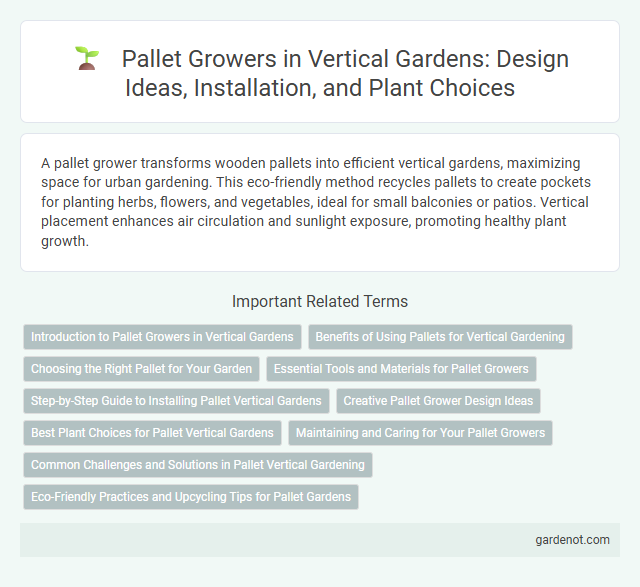A pallet grower transforms wooden pallets into efficient vertical gardens, maximizing space for urban gardening. This eco-friendly method recycles pallets to create pockets for planting herbs, flowers, and vegetables, ideal for small balconies or patios. Vertical placement enhances air circulation and sunlight exposure, promoting healthy plant growth.
Introduction to Pallet Growers in Vertical Gardens
Pallet growers in vertical gardens transform wooden pallets into multifunctional planting structures, maximizing space for urban gardening and small-scale farming. These vertical pallets offer efficient drainage, easy customization, and promote sustainable reuse of materials, making them ideal for cultivating herbs, vegetables, and flowers in limited areas. Incorporating pallet growers supports eco-friendly gardening practices and enhances aesthetic appeal in residential and commercial spaces.
Benefits of Using Pallets for Vertical Gardening
Pallet growers maximize space by transforming reclaimed wood pallets into vertical gardens, ideal for small urban areas and balconies. These pallets provide excellent drainage and aeration, promoting healthier plant roots and reducing water waste. Using pallets for vertical gardening supports sustainability through recycling materials and encourages efficient use of limited growing areas.
Choosing the Right Pallet for Your Garden
Selecting the right pallet for your vertical garden involves prioritizing untreated, chemical-free wood to ensure plant safety and healthy growth. Opt for pallets made from hardwoods like oak or maple, which provide durability and weather resistance essential for outdoor use. Verify the pallet's stamping codes, avoiding those treated with harmful substances such as methyl bromide (marked as MB), to maintain an eco-friendly and safe gardening environment.
Essential Tools and Materials for Pallet Growers
Pallet growers require essential tools and materials such as untreated wooden pallets, landscape fabric for moisture control, and high-quality potting soil to ensure plant health. Waterproof liners protect the wood from rot while nails or screws provide sturdy assembly for vertical stability. A variety of seeds or seedlings suited for vertical gardening enhances growth efficiency in pallet gardens.
Step-by-Step Guide to Installing Pallet Vertical Gardens
Begin by selecting untreated wooden pallets to ensure safety for plants and the environment. Secure landscaping fabric inside the pallet to contain soil while allowing drainage, then fill it with a nutrient-rich potting mix tailored for vertical gardening. Position the pallet vertically against a wall or sturdy frame, anchor it securely, and plant a variety of herbs, succulents, or small vegetables suited for vertical growth.
Creative Pallet Grower Design Ideas
Creative pallet grower designs transform reclaimed wooden pallets into vertical gardens that maximize limited spaces while enhancing aesthetic appeal. Incorporating features like tiered planters, built-in irrigation systems, and modular sections allows for versatile cultivation of herbs, succulents, and flowers. Innovative designs also integrate decorative elements such as painted patterns or mixed materials to create functional living art installations.
Best Plant Choices for Pallet Vertical Gardens
Pallet vertical gardens thrive with compact, low-maintenance plants such as succulents, herbs like basil and thyme, and trailing vines including pothos or ivy. These species adapt well to limited soil depth and benefit from vertical air circulation, promoting healthy growth and efficient space use. Selecting plants with similar water and sunlight needs ensures consistent care and vibrant pallet garden aesthetics.
Maintaining and Caring for Your Pallet Growers
Maintaining and caring for your pallet grower involves regular watering to keep soil consistently moist without overwatering, ensuring healthy plant growth. Inspect plants frequently for pests or diseases, and prune dead or overgrown foliage to promote airflow and prevent mold. Fertilize monthly with a balanced, water-soluble fertilizer tailored for container gardening to support vigorous development in vertical garden systems.
Common Challenges and Solutions in Pallet Vertical Gardening
Pallet growers in vertical gardening often face challenges including limited soil depth, poor drainage, and uneven sunlight exposure, which can hinder plant growth and root development. Solutions involve using high-quality, lightweight potting mix to optimize soil conditions, incorporating drainage holes or liners to prevent waterlogging, and strategically positioning the pallet for maximum sun exposure throughout the day. Regular monitoring for pests and diseases combined with appropriate vertical garden irrigation systems enhances plant health and yields.
Eco-Friendly Practices and Upcycling Tips for Pallet Gardens
Pallet growers embrace eco-friendly practices by repurposing discarded wooden pallets into vertical garden structures, reducing waste and promoting sustainability. Incorporating natural, non-toxic finishes and organic soil enhances plant health while minimizing environmental impact. Upcycling tips include sanding rough edges, reinforcing structural stability, and selecting drought-tolerant plants to optimize pallet garden longevity and resource efficiency.
Pallet grower Infographic

 gardenot.com
gardenot.com